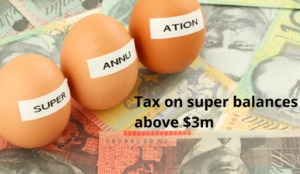Regardless of the changes below, Superannuation, in our view, remains the most tax-effective structure and provides the opportunity for many clients to work towards a tax-effective and tax-free retirement.

From 1 July 2026, employers are to pay SG at the same time as their salary and wages
The government has announced changes to paying employees’ superannuation guarantee (SG) entitlements. Currently, employers are required to pay SG contributions quarterly. However, under the new announcement:
- Employers must pay employees’ SG contributions simultaneously with their salary and wages. This change simplifies the process and enables employees to easily track their superannuation payments, ultimately enhancing their retirement benefits.
- The government provides an example to illustrate the potential impact of this change. For instance, a 25-year-old individual with a median income who currently receives wages fortnightly but superannuation contributions quarterly could be approximately $6,000 or 1.5 per cent better off at retirement.
- Additional funding will be allocated to the Australian Taxation Office (ATO) in the 2023–24 fiscal year to strengthen its capabilities in identifying and taking action against cases of SG underpayment by employers.
It is important to note that the government’s announcement does not include any exemptions for small businesses. Therefore, this proposed change will apply to all employers who do not already pay superannuation simultaneously as salary and wages. However, employers will have until July 1, 2026, to prepare for this change, assuming it is legislated.
This announcement relates to superannuation guarantee contributions and is unlikely to affect salary sacrifice contributions. The timing of salary sacrifice contributions will continue to be determined by the written agreement between employees and employers.
$3m total super balance tax
The government has recently announced its plans to reduce the tax concessions available to individuals whose total super balance exceeds $3 million, effective July 1, 2025. This reform aims to ensure that superannuation concessions are targeted more effectively and remain sustainable. Here are the critical points of the announcement:
 This reform will not affect individuals with a total super balance of less than $3 million.
This reform will not affect individuals with a total super balance of less than $3 million.- For individuals whose total super balance exceeds $3 million, the headline tax rate on earnings will increase from 15 per cent to 30 per cent. This higher tax rate will apply to the proportion of earnings corresponding to the portion of an individual’s total super balance that exceeds $3 million. However, it is essential to note that this rate is still lower than the top marginal tax rate of 45 per cent. Earnings related to assets below the $3 million threshold will continue to be taxed at the current rates of 15 per cent or zero per cent if held in a retirement pension account.
- Interests in defined benefit schemes will be appropriately valued, and their earnings will be taxed under this measure in a manner consistent with other interests. This will ensure equitable treatment across different types of superannuation interests.
The government announced this measure in February 2023 and has since engaged in industry consultation. However, the specific technical details of how this will operate have not been provided in the Budget announcement. Further clarity on aspects such as the treatment of contributions and withdrawals for earnings calculations will be provided by introducing legislation.
The industry has raised concerns about the $3 million threshold and has called for it to be indexed to account for inflation and prevent more individuals from being subject to the proposed tax over time. However, the government has not provided any indication in the Budget announcement about considering indexation when the legislation is introduced.
This measure is designed to ensure that superannuation tax concessions are targeted appropriately and remain sustainable. Further details will be provided through the legislative process, clarifying the technical aspects and addressing industry concerns.
Non-arm’s length expenses and non-arm’s length income
The government has announced amendments to the Non-Arm’s Length Income (NALI) rules for Self-Managed Superannuation Funds (SMSFs) and Small APRA Funds. The aim is to limit income taxation as NALI when a fund incurs a general fund expense at a rate below the market rate. Here are the critical points of the announcement:
- Currently, if a fund incurs a general fund expense under a scheme at a rate below the market rate, the non-arm’s length expense is connected to all the income derived by the fund in that year. As a result, 100% of the fund’s income, including exempt pension income and assessable contributions, is treated as NALI and taxed at a rate of 45%.
- Under the government’s proposal, the amount of the fund’s NALI attributed to incurring a non-arm’s length expense of a general nature will be limited. It will be limited to 2 times the level of the expenditure breach, which is calculated as the difference between the amount that would have been charged to the fund as an arm’s length expense and the actual amount charged.
- The government’s proposal will exempt expenditure before the 2018-19 financial year.
- Large APRA-regulated funds will be exempt from the NALI provisions for both general and specific fund expenses.
These changes are intended to provide more clarity and fairness in taxing income derived from non-arm’s length expenses. By limiting the amount of income subject to NALI and providing exemptions for certain funds and pre-2018-19 expenditures, the government aims to ensure a more equitable tax treatment for SMSFs and Small APRA Funds.
The government’s announced changes regarding the Non-Arm’s Length Income (NALI) rules have been well received as they address the issue of excessive taxation on a fund’s income in cases where non-arm’s length expenses are incurred. However, it is essential to consider some key points about these changes:
- While the changes aim to prevent a fund from being taxed at the highest rate on all its income due to a non-arm’s length expense, there can still be a significant tax penalty depending on the extent of the breach. For instance, if a fund incurs a general fund expense that is $3,000 below what it should have been charged, the resulting non-arm’s length income tax liability would be $2,700 (calculated as $6,000 multiplied by 45%).
- It is crucial to note that the NALI provisions pertaining to specific assets, where an SMSF or small APRA fund incurs non-arm’s length expenses, remain unaffected by this announcement. These provisions continue to apply separately and are not impacted by the changes mentioned.
While the announced changes are a positive step towards ensuring a fairer tax treatment for funds with non-arm’s length expenses, individuals and organizations need to consider the potential tax implications based on the specific circumstances and the extent of any breaches.



